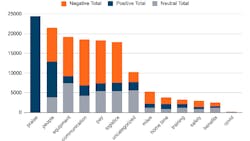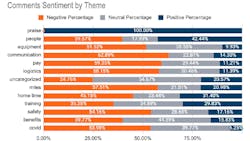Report emphasizes empathetic engagement for happier drivers
Drivers were quick to praise employers in 2022, but economic headwinds such as low freight volumes led to concerns about pay and lower employee satisfaction, underscoring the importance of clear communication from carriers to drivers, according to data collected by driver feedback platform Workhound.
For the first time in the company's history since 2015, Workhound measured in its annual report that drivers' praise for their carriers was the most common comment category, with positive support for fellow workers also being a common theme. However, overall driver satisfaction was lower than in 2021, due largely to pay concerns.
"Drivers are often very fair-minded, respectful people who are willing to praise the efforts and others because they want to be appreciated for their own contributions as well," said Jerome You, senior customer success manager at Workhound, during a March 14 webinar on the report.
See also: Pre-Trip: Voie looks back on 16 years of WIT and toward the future
Poor communication affects driver pay concerns
For negative feedback, the top criticism drivers had of carriers was poor communication—which was only No. 6 last year. This was followed closely by pay, which was 2021's top issue. However, the company's pay trends report from October indicated that only 27% of pay comments were regarding the rates themselves, despite 60% of comments related to pay being negative in 2022. Many negative comments included a combination of these two critiques—criticizing poor communication about pay.
"Drivers experience a lot of volatility, maybe making a few hundred one week to a few thousand the next, depending on the miles," You said, adding that many driver criticisms come from convoluted or unclear pay structures. This dovetails with communication being a common complaint because drivers are sometimes unsure during onboarding how pay will be calculated at a given carrier.
See also: Culture of transparency fuels Best Fleets to Drive For winner
Additionally, freight volumes have been low, leading drivers to become increasingly concerned that they will not be able to drive the miles they need to earn a living.
"The pay structure in trucking is the most complicated pay structure out of any industry in North America," Max Farrell, Workhound CEO and co-founder, said during the webinar, later telling FleetOwner that there's uncertainty because "of hoops for people to jump through. Like if you have detention pay, you've got to go through and hit these buttons on your in-cab device," citing layover and breakdown pay as other forms of compensation that, if not explained properly, could lead to driver confusion.
Drivers often cited feeling misled by recruiters, saying that the recruitment process set unreasonably high expectations of payment.
"The biggest danger that I see in some of the comments I get from newer drivers is, 'Hey, this pay rate was advertised; I am nowhere close to that,'" said You, advising that, while the pay conversation is unavoidable, carriers emphasize benefits in their recruitment efforts.
'Benefits+'
Farrell said that, while companies can't ignore pay, they can sway prospective drivers by supplementing with benefits—and what the CEO calls "benefits plus," meaning that, in addition to traditional benefits like healthcare and 401(k) plans, companies should also consider home time, mental health, and family planning for recruitment and retention.
"If you're saying, hey, we don't have the highest pay in the area, but we have greater home time than someone else, or we're able to meet 90% of all your mileage goals week over week compared to the peers only meeting 75%, and we can provide greater consistency and stability," that could be attractive to drivers, Farrell said.
Of comments related to home time, 31% were positive in 2022. Often these messages indicated drivers' appreciation for employers who offer specialized wellness programs, flexible scheduling, home time guarantees, and other programs to help drivers maintain a healthy work-life balance, according to the report.
Farrell also said that, in the past year, he has seen more companies start to explore a guaranteed minimum pay, noting that it could be an effective recruitment tool for some drivers.
Respond quickly for better retention
Farrell told FleetOwner that the report underscores the importance of communication as a retention tool, saying that listening to drivers' individual concerns instead of relying solely on annual surveys and exit interviews allows companies to quickly respond and address issues that might otherwise cause that worker to leave.
Farrell gave an example of a driver that used Workhound to ask why his wife was not on his insurance. His employer realized that there had been a paperwork error and, using the platform, spoke to the driver, deftly resolving a miscommunication that could have led to that worker's resignation.
Perfect is the enemy of good when it comes to communication, Farrell said, emphasizing the importance of a speedy response: "One of the challenges and mindset issues that exist in this industry is that, 'Oh, we can't respond every hour on the hour, so we're going to do nothing.' And that's where I say, even if you get to it in a day, that's still better than doing nothing at all and not having a place for your workforce to share what's on their mind."
Carriers must also communicate with drivers about their recruiting efforts, Farrell told FleetOwner. Companies can't "turn off" the "recruiting machine" when freight volumes are low, he acknowledged, because the momentum of such programs would take months to return. He has seen this lead drivers to question why their carriers are recruiting when freight volume is scarce. Farrell suggested companies explain to drivers that ongoing recruiting will be more selective, intended only to replace lost drivers and not to expand the workforce. He also recommended that companies highlight what freight opportunities they are creating, such as through new contracts, or from work with brokers.
Additionally, carriers can improve retention by ensuring dispatch stays in contact with drivers, Farrell said, explaining that, if a driver cannot easily reach out to dispatch to find the next load, "That silence becomes a vulnerable time where a driver can be like, 'I guess my company doesn't have enough for me to do,' and it's really easy for them to start browsing other job opportunities in that brief window."
Ultimately, Farrell emphasized some of the positive trends of the report, such as the frequency of praise and positive comments regarding people, as well as the slight alleviation of equipment supply concerns since the year prior, as causes for optimism.
"I think this industry has a bad habit of always trying to fix what's broken instead of celebrating what's working well. And I think this was a really good reminder that it is important to recognize the positive and that while there's a lot of stuff to improve in this industry, and a lot of challenges now and ahead of us, drivers will recognize when things are going well."
About the Author
Scott Keith
Scott Keith is a former fleet owner digital editor, who was on staff from 2022 to 2023.




